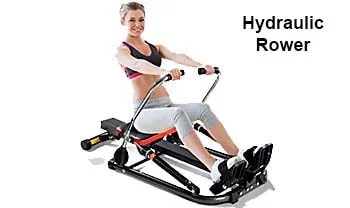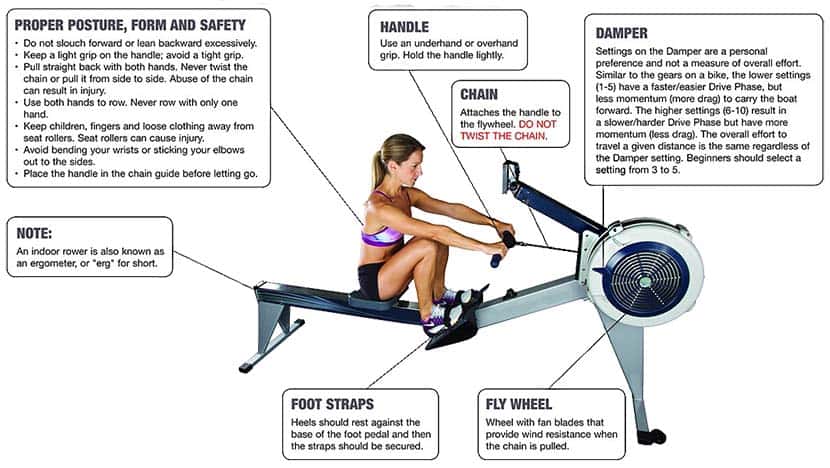
Table of Contents
Know About Your Rowing Machines – Info Bitz
This Rowing Machine Info page will introduce you to the basics of a rowing machine, its types, and its terms.
Reasons to use a Rowing Machine
– Fitness / Tone up
– Weight loss
– Build Strength
– Well-being / Enjoy a physical activity
– It works on almost all Muscle groups, bones, joints, and the cardiovascular system
– Burns more calories than most other exercises. One hour of strenuous rowing will burn around 800 calories! (Compare that to One hour walking burns 300 calories, Swimming burns 600 calories, Running 650-700 calories).
– Improve your posture (with a specific technique)
– Requires less space than most other fitness equipment
Many people think that a rowing machine mainly works your arms, but it’s actually your legs that should do the bulk of the work. In fact, it should actually be 60% legs, 20% core, and 20% arms.
There are 4 Types of Rowing Machines
(1) Hydraulic Rowing Machine
The hydraulic rowing machine may be the best way to go if space is a concern and you’re on a tight budget. Hydraulic rowing machines receive its tension from the amount of air or fluid that’s compressed with a cylinder or piston. The tension can be adjusted by most models of indoor rowers.
These Rowers differ from air, magnetic, and water rowers. The rowing technique doesn’t allow you to pull in a straight line. Most hydraulic piston-based rowers require you to be placed in an exercise position that does not allow you to perform a natural rowing motion. As such, you are unable to naturally synchronize your arm and leg movements together. These Rowers are normally smaller and quieter. Suitable for those just starting out.
(2) Magnetic Rowing Machine
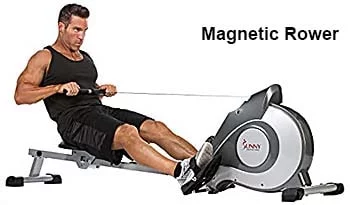 A magnetic resistance fitness rowing machine can provide smooth rowing stroke and is known for being virtually noiseless as magnetic resistance produces very little or no friction. Unlike Air Rowers which use flywheels for its resistance Magnetic rowers utilize magnetic brake system, thus providing a silent workout.
A magnetic resistance fitness rowing machine can provide smooth rowing stroke and is known for being virtually noiseless as magnetic resistance produces very little or no friction. Unlike Air Rowers which use flywheels for its resistance Magnetic rowers utilize magnetic brake system, thus providing a silent workout.
Normally rowing machines based on magnetic resistance are available utilizing only magnet resistance or a combination of magnetic and air resistance. These machines could be a bit pricey depending on the brand and model.
(3) Air Rowing Machine
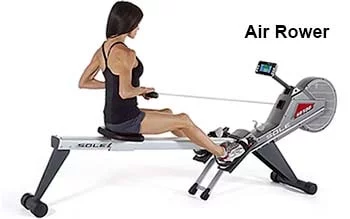 The air or flywheel-based rowing machine for exercise offers a similar feel to outdoor rowing. An Air rower receives its resistance from the pulling motion, which spins a flywheel. The resistance is provided by the wind.
The air or flywheel-based rowing machine for exercise offers a similar feel to outdoor rowing. An Air rower receives its resistance from the pulling motion, which spins a flywheel. The resistance is provided by the wind.
To increase the resistance of a flywheel rowing machine, you need to pull harder. This will move the flywheel faster, and greater wind resistance is provided by the fan blades.
Compared to hydraulic-based rowing machines, air rowing machines provide a more natural rowing stroke but are a bit noisier than the former.
Concept2 rowing machines which are very popular are based on a flywheel system.
(4) Water Rower
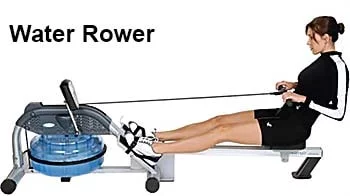 The Water Rower is ideal for those who participate in outdoor rowing. The Water Rower’s Flywheel has been uniquely designed to emulate the dynamics of a boat moving through water. It gives the feeling of just like rowing outdoors. WaterRowers’ flywheel receives its resistance from the effects of drag as water moves past the tank. This indoor rower is also pretty quiet when in use except you hear the swishing of the water while using this rowing machine.
The Water Rower is ideal for those who participate in outdoor rowing. The Water Rower’s Flywheel has been uniquely designed to emulate the dynamics of a boat moving through water. It gives the feeling of just like rowing outdoors. WaterRowers’ flywheel receives its resistance from the effects of drag as water moves past the tank. This indoor rower is also pretty quiet when in use except you hear the swishing of the water while using this rowing machine.
Most WaterRowers are constructed with wooden frames. This makes this rowing machine very attractive. This helps to dampen the mechanical vibrations which are common to other indoor rowers.
Another model of water-based rowing machine is the First Degree Fitness Fluid Rowing Machine.
Water Rowers are a bit expensive, usually around £1000. Good for strength and muscles
Reviewed Rower Types
Concept 2 Model D Rowing Machine – Type: Flywheel Air Resistance
Bodymax R100 Rowing Machine – Type: Air-Magnetic combination
Concept 2 Rower Model E – Type: Flywheel Air Resistance
Kettler AXOS Rower – Type: Magnetic Resistance
Water Rower A1 – Type: Water Resistance
JLL R200 Rower – Type: Magnetic Resistance
JTX Freedom Air Rowing Machine – Air-Magnetic combination
Nordic track RX800 – Type: Air Resistance
Reebok GR Rowing Machine – Electronic Resistance
V Fit tornado Rowing Machine – Air Resistance
Viavito Sumi Rowing Machine – Flywheel & Magnetic Resistance
York Fitness R301 Rowing Machine – Air-Magnetic combination
For brief reviews on all the above Rowers please visit the Home page.
Fixed vs folding
When you’re considering the size of a rowing machine, you should also think about whether a fixed or folding model is the best fit for your home.
A fixed rowing machine doesn’t fold up for storage, so you’ll need enough room to accommodate it as is. Keep in mind that fixed machines are often more durable, though.
A folding rowing machine does just what the name implies: it folds up to require less storage space. For indoor use, many users find a folding machine more convenient.
Folding rowing machines are a great choice if you don’t have a large, dedicated exercise space in your home or apartment.
Rowing Strokes
Stroke – one full rowing action comprising of four phases:-
Catch – set-up for the next phase
Drive – generates the power
Finish – also called the Release is the end of the stroke
Recovery – slide back to the catch position
Steady Rowing: 18-24 strokes per minute (also known as Rating). This comfortable or warm-up workout. Not suggested for weight loss or fitness.
Interval Training: One or two minutes alternate between 20 strokes/min and 30 strokes/min. It Burns more calories than steady rowing.
High-Intensity Rowing: Hard and fast rowing for a pre-determined period. This is not for beginners but beneficial to Intermediate and Advanced users. Helps stamina, and mental and physical abilities.
Pyramid: meant for elite Rowers. Suggested stroke rates: 4 mins at 22 strokes/min > 3 mins at 24 strokes/min > 2 mins at 26 strokes/min > 1 min at 28 strokes/min
Time Trials – Type of workout where you record your time to row a pre-determined distance (usually 2,000 meters), or record your distance rowed within a target time, for example, 2 minutes. The results can be used to judge your progress over time.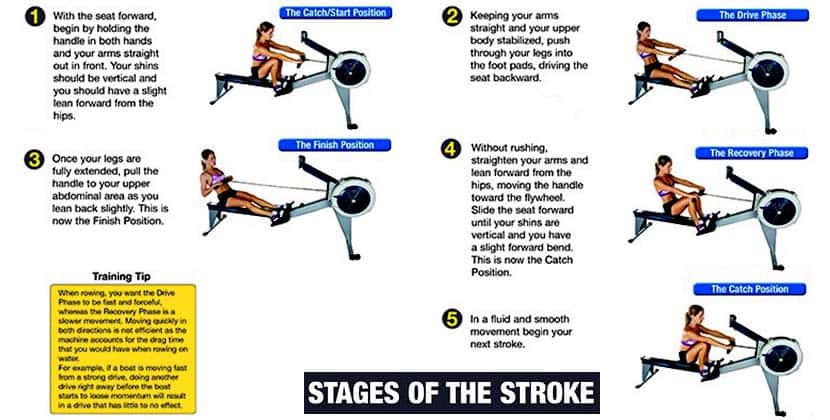
Rowing Machine Terminology & Abbreviations
Aerobic – Good for stamina
Anaerobic – Good for strength
BPM – Beats Per Minute
BRIC – British Rowing Indoor Championships (was previously BIRC). Has moved around venues but now moving to London, UK
Dead spot – Part of the stroke with a drop in resistance. Quality rowing machines normally do not have a dead spot and you’ll feel the tension on the chain throughout the whole stroke.
Display – Shows your workout data like the distance you rowed, the time it’s taken, strokes per minute, calories used and pulse rate, etc. The high-end models allow you to download the data to your PC.
DPS – Distance per Stroke (a good indicator of technique. Displayed on the Rowpro software)
EIRC – English Indoor Rowing Championships – held at the National Cycling Centre, Manchester, UK
Ergometer: Rowers call it an “erg.” Also ergo for short and refers to an indoor rowing machine. It’s a rowing machine that closely approximates the actual rowing motion. A rowing machine equipped with a device for measuring the work done by human muscles. Indoor rower, called an ergometer by rowers.
Flywheel – The part that creates the resistance. It is connected to the chain and spins when you pull back on the Drive part of the stroke. The braking mechanism on the flywheel gives the feeling of an oar moving through water.
Footplates – It’s where you strap in your feet. To complete the recovery part of the stroke you need to secure your feet in place.
Folding model – many Rowers can be folded at the end of the rail to allow for easy storage when not in use. If choosing a folding rower check it comes with transport wheels
Handle – also called the bar, is attached to the chain and replicates the handles of an oar. Normally handle should be padded and slightly oval (cross-section) to allow for a good grip. A poorly designed handle can cause blistering to the palm.
Heart Rate Monitor – designed for recording heart rate information. They are very useful for monitoring the risk of over-training and alerting that it may be time to reduce the training load. Pulse rate data is collected through either a wrist or chest strap or ear clip and sent to the rowing machine’s computer. Chest strap normally is the best, providing the most accurate reading.
Heart Rate Programs – use the readout from a heart rate monitor to change the resistance or set target stroke rates to get you into the fat-burning or maximum heart training zones.
HRT – Heartrate (in BPM)
IIRC – Irish Indoor Rowing Championships
Log Card – Credit card shape/size “memory stick” that can be inserted into the PM3/4/5 models. This allows you to record your training on any machine even when you travel and use different gyms. Up to 5 users can share the same card but still keep their logs separate.
Low Impact (in our details) means – Less stress on your joints
PM (Performance Monitor) – It’s the screen that displays/records your workout. PM2 is the older version. Surpassed by the PM3, then the PM4, and very recently the PM5 with more functionality.
Rail – is the central beam for the seat to roll up and down. It should be sturdy and well-supported. Most rails are made from extruded metal.
Resistance mechanism – The part of the rowing machine that creates the resistance. These could be hydraulic, air, magnetic, or water.
Rowpro – A software program was written specifically for allowing people to race in real time over the internet against anyone (or themselves). Information is taken directly from the PM via a USB cable.
Seat Rollers – the bearings or wheels that allow the seat to slide up and down on the rail.
SIRC – Scottish Indoor Rowing Championships
SPM – Strokes Per Minute (how many times you pull the handle per minute)
Tabata Workouts – named after the founder, Izumu Tabata, also call Wattage workouts, are based on a target number of watts you can produce based on your body weight.
Transport Wheels – rollers embedded into the feet of a rowing machine that makes it easy to move around and prevents damage to your floor.
Wattage/ Watts – you may see this on your display. This is the amount of energy you’re producing with each stroke. The higher the number, the harder you’re working.

